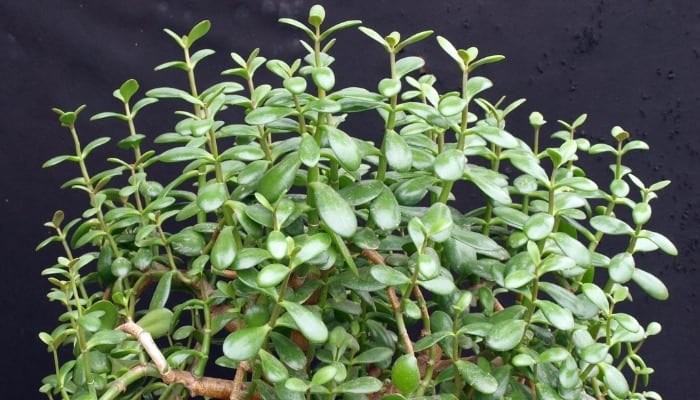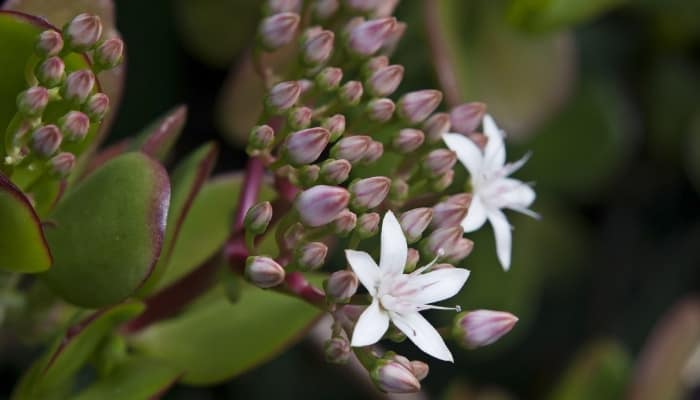If you are a fan of succulents, you are likely familiar with the jade plant.
This popular plant, of which there are over 200 varieties, is native to Southern Africa and is also often called Crassula ovata or Crassula argentea.
The jade plant features oval leaves that are thick and fleshy with woody stems that are somewhat reminiscent of tiny tree trunks.
Dark glossy leaves and pink flowers make the jade a sought-after plant during the winter-spring periods.
Although they are evergreen plants, sometimes there can be a reddish tinge to the edges of the leaf, creating a beautiful splash of color.
How often do jade plants flower? Jade plants do not flower often and won’t bloom until the age of 2-3 years old. They don’t flower annually unless kept in the perfect environment that encourages blooming, which is a dry, sunny, bright environment with temperatures that don’t drop below 10℉ at night and with little to no humidity.
For some, the jade plant is a symbol of luck, and it is also often thought of as a “money tree.” Some believe that placing a jade plant by the front door brings harmony into the home.
Jade Plant Flowers
The jade plant grows mainly in warm, dry conditions, preferring 60-75℉ to survive. A jade plant makes a delightful house plant and continues to live for many years in the right environment.
They grow mainly in Mozambique and South Africa; however, they are also found to thrive in the USA and Asia.
The jade presents small white or pink star-shaped flowers that grow in clusters. The flowers start out as buds with pink sepals that later open.
When the plant does bloom, two to three clusters will open.
Does a Jade Plant Flower?
The jade plant does flower, although it is rare. Some jade plants will flower happily each year, while some will bloom sporadically or not at all.
If the plant does flower, it will be in late winter or early spring.
Do All Jade Plants Flower?
While all jade plants can flower, it doesn’t mean that they will. They tend to only bloom when in the ideal environment, which can be challenging to achieve.
You won’t see flowers on your jade plant for at least the first two to three years.
What Do Jade Flowers Look Like?
Jade flowers are pink or white star-shaped flowers in round clusters. The buds begin with pink sepals, which open and present as small, delicate flowers.
The clusters of flowers will flower for short periods, and if deadheaded regularly when the flowers turn brown, they will flower longer.
Jade Plant Flowering Season
The flowering season for a jade plant is late winter and early spring into summer, especially in its native environment.
This is because that is when the weather is conducive for flowering.
How Old Does a Jade Plant Have To Be To Flower?
A jade plant will need to be mature enough to produce flowers, which is usually two to three years old. That said, some jade plants suddenly burst into bloom after 10 years.
It’s important to note that your jade plant may never flower at all.
Do Jade Plants Flower Every Year?
While some jade plants flower annually, it is not always the case. Some might say that it’s the luck of the draw with jade plants.
How Long Do Jade Plant Flowers Last?
Many jade plant appreciators pass the plant down generationally because they are known to last between 50 and 70 years (or even longer)!
Of course, for this to be possible, the plant must be properly cared for.
As for the flowers themselves, they do not last very long. Depending on conditions, flowers may lasts for a few days or a few weeks.
How To Get a Jade Plant To Bloom
The trick to getting a jade plant to bloom lies in the length of night and day to which the plant is exposed.
The age of the plant is also significant as the jade plant needs to be mature and usually older than three years old.
With some effort, you can get a jade plant to flower. Your jade plant will require low watering, cool nights, and bright daylight. These conditions will help the plant form buds and flowers.
Jade plants need adequate sunlight and a correct watering schedule. Overwatering will cause the plant to drop its leaves and turn yellow.
As a typical succulent, the jade plant prefers arid ambient environments; ensuring the inside conditions are not too humid will encourage the plant to form buds.
Another critical factor is to expose the plant to cooler nighttime temperatures but nothing below 10℉.

Jade Plant Care Indoors
Although jade plants grow well outdoors in their native countries, they can also flourish indoors.
They can be grown in the right conditions with great success indoors, making a lovely talking piece for any home. Consider the factors of growing jade plants indoors below.
Jade Plant Soil
To grow jade plants successfully, the soil needs to drain quickly, be grainy, and be slightly acidic or neutral.
Although the perfect pH for this plant is 6.0 to 7.0, recommended soil would be soil suitable for succulents (like this one) with added compost or organic matter.
Where To Place a Jade Plant In Home
If you believe in luck and harmony in the home, then place your jade plant in front of the main front door to your home. This is thought to bring luck to your home.
In addition, some cultures believe that by following Feng Shui practices, placing your Jade plant in the eastern section of your home promotes harmony in the family and brings prosperity.
These beliefs and ideas aside, the jade plant is a slow-growing plant that will only grow 2 inches a year and needs lots of light and indirect sunlight to flourish.
Therefore, they should receive four to six hours of daily sunlight to grow strong and mature. Place them in a room near a window where there is sufficient light.
Jade Plant Watering
Jade plant watering is somewhat of an art. Essentially, you should keep the soil moist but not drenched during the spring and summer months. Only water when the soil is dry to the touch.
Slowly reduce the watering through autumn, and in winter, keep to watering only once a month.
If there is excess water in the plant saucer, empty it as jade plants do not like sitting in water.
Jade Plant Fertilizer
During winter, it is not necessary to fertilize your jade plant constantly.
Still, as spring approaches, it’s good to start applying a slow-release fertilizer and continue with a gentle liquid fertilizer solution throughout the season.
For young plants, use a fertilizer that has less concentration of nitrogen.
Jade Plant Pruning
The optimum time to prune your jade plant is spring or early summer. Choose a warm, dry day so that it forms a callous to seal the cut easily.
Only remove a maximum of 30% of the plant at any one pruning session, and only prune a healthy plant.
Do not cut the main trunk of your jade plant. Just prune the branches that come off the main stem.
Conclusion
Jade plants are succulents with many things in common with aloes and sedums. They are mildly toxic to people, causing nausea if eaten and skin irritation in some people.
It is important to note that it is a highly toxic plant to animals, especially cats, dogs, and horses.
With a long lifespan and the fact that it is exceptionally easy to propagate, the jade plant has become popular to share with friends and family.
Provide the perfect blooming environment for your jade plant, and you never know – it may even treat you to some of its beautiful clusters of star-shaped flowers.

